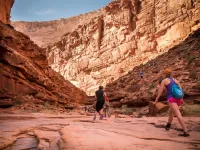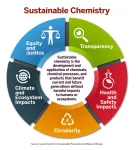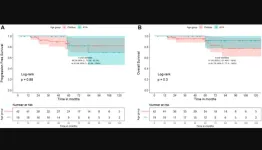(Press-News.org) People often say things like Phoenix has always been dry; Seattle has always been wet; and San Francisco has always been foggy. But “always” is a strong word.
A study from the University of California, Davis, synthesizes climate trends across the Western U.S. during a relatively young period of Earth’s history — the Holocene Era, which stretches from the present day to the past 11,000 years. This look at the really Old West shows that the hallmarks of California’s climate — the foggy coastlines that gave rise to towering redwoods, the ocean upwelling that spawned productive fisheries, the warm summers and mild winters — began around 4,000 years ago.
It also reveals a time when the Pacific Northwest was warm and dry and the Southwest was warm and wet.
An understudied era: The current one
Published in Climate of the Past, a journal of the European Geosciences Union, the study provides a baseline against which modern climate change in the region can be considered. It also sheds light on a lesser-studied geological epoch — the current one, the Holocene.
“We kept looking for this paper, and it didn’t exist,” said lead author Hannah Palmer, who recently earned her Ph.D. from the UC Davis Department of Earth and Planetary Sciences. “There are many records of past climate for a single location, but no one had put it all together to understand the big picture. So we decided to write it.”
The authors analyzed more than 40 published studies, examining the interplay among land and sea temperature, hydroclimate and fire activity across three distinct phases.
The study found:
Compared to pre-Holocene conditions (the last Glacial period), the Early Holocene (11,700-8,200 years ago) was a time of warm seas, a warm and dry Pacific Northwest, a warm and wet Southwest and fairly low fire activity.
By the Middle Holocene (8,200-4,200 years ago), that pattern reversed: The ocean’s surface cooled, the Pacific Northwest became cool and wet, and the Southwest became drier.
The Late Holocene (4,200 years ago-present) is the most climatically variable period. It marks a period when the “modern” climate and temperature patterns are established. The study noted a defined interval of fire activity over the past two centuries that is linked to human activity.
Unprecedented interval
The study also considered the impact of humans on environmental changes at the time, noting that the Era of Colonization (1850-present) represents an unprecedented environmental interval in the climate records.
“Humans have been living here throughout the entire Holocene,” Palmer said. “The climate impacted them, and they impacted the climate, especially in recent centuries. This paper shows how that push and pull has changed over the past 11,000 years.”
Different responses
“Sometimes people point to recent rain or cold snaps as evidence against climate change,” said co-author Veronica Padilla Vriesman, a recent Ph.D. graduate from UC Davis Department of Earth and Planetary Sciences. “This study illustrates how different regions respond differently to global climate changes. That long-term perspective helps us understand the historical climate of the western U.S. and how it may respond moving forward.”
The study stemmed from a graduate seminar about the Holocene period led by Tessa Hill, a professor in the Department of Earth and Planetary Sciences and associate vice provost of Public Scholarship and Engagement. Additional co-authors include Caitlin Livsey and Carina Fish. All authors were part of Hill’s Ocean Climate Lab at the UC Davis Bodega Marine Laboratory in the Department of Earth and Planetary Sciences.
“Climate records from the Holocene provide a valuable window into the context of human-caused climate change,” said Hill. “They provide an opportunity for us to understand places that may be more or less resilient to change in the future.”
The study was funded by the National Science Foundation.
END
Climate trends in the west, today and 11,000 years ago
What we think of as the west coast’s climate is ‘only’ a few thousand years old
2023-02-27
ELSE PRESS RELEASES FROM THIS DATE:
Mysteries of the Earth: FSU researchers predict how fast ancient magma ocean solidified
2023-02-27
Early in the formation of Earth, an ocean of magma covered the planet’s surface and stretched thousands of miles deep into its core. The rate at which that “magma ocean” cooled affected the formation of the distinct layering within the Earth and the chemical makeup of those layers.
Previous research estimated that it took hundreds of million years for that magma ocean to solidify, but new research from Florida State University published in Nature Communications narrows these large uncertainties down to less than just a couple of million years.
“This magma ocean has been an important part of Earth’s history, and this study helps us answer ...
The Texas Heart Institute delivers a new first in heart failure treatment using cell therapy
2023-02-27
Houston, TX – February 27, 2023 – Physician-scientists at The Texas Heart Institute announced today the results of the largest cell therapy trial to date in patients with chronic heart failure due to low ejection fraction. The therapy benefited patients by improving the heart’s pumping ability, as measured by ejection fraction, and reducing the risk of heart attack or stroke, especially in patients who have high levels of inflammation. Also, a strong signal was found in the reduction of cardiovascular death in patients treated with cells. The findings ...
Augmented reality headset enables users to see hidden objects
2023-02-27
MIT researchers have built an augmented reality headset that gives the wearer X-ray vision.
The headset combines computer vision and wireless perception to automatically locate a specific item that is hidden from view, perhaps inside a box or under a pile, and then guide the user to retrieve it.
The system utilizes radio frequency (RF) signals, which can pass through common materials like cardboard boxes, plastic containers, or wooden dividers, to find hidden items that have been labeled with RFID tags, which reflect ...
How common is face blindness?
2023-02-27
How Common Is Face Blindness?
Study suggests condition affects more people than previously thought
For Immediate Release
Media Contacts:
Dennis Nealon
Dennis_Nealon@hms.harvard.edu
508-494-6117
Ekaterina Pesheva
Ekaterina_Pesheva@hms.harvard.edu
617-432-0441
At a Glance:
Study by researchers at Harvard Medical School/VA Boston Healthcare System suggests that face blindness lies on a continuum and may be more common than currently believed.
The study found similar face matching performance between prosopagnosics diagnosed with stricter vs. looser criteria, suggesting that the diagnostic criteria should be expanded.
As many as ...
Midwifery care safe for moderate- and high-risk pregnancies
2023-02-27
New UBC research shows that midwives in British Columbia are providing safe primary care for pregnancies of all medical risk levels, contrary to a popular belief that midwives mostly manage low-risk pregnancies.
The study, published in the Canadian Medical Association Journal, examined a decade of births in B.C. between 2008 and 2018. The researchers compared birth outcomes for people who had a midwife as their most responsible provider (MRP), with those who were cared for by a family physician or obstetrician.
The findings reveal that people who had a ...
Sustainable chemistry experts create blueprint for safer future
2023-02-27
Feb. 27, 2023
Media contacts:
Emily Gowdey-Backus, director of media relations, Emily_GowdeyBackus@uml.edu
Nancy Cicco, assistant director of media relations, Nancy_Cicco@uml.edu
Sustainable chemistry experts create blueprint for safer future
Group to share its work during free UMass Lowell webinar on March 1
Toxic chemicals – which pop up in everything from household cleaners and appliances to medical devices, paints, packaging and more – are all around. The February ...
Early-life stress can disrupt maturation of brain’s reward circuits, promoting disorders
2023-02-27
Irvine, Calif., Feb. 27, 2023 — A new brain connection discovered by University of California, Irvine researchers can explain how early-life stress and adversity trigger disrupted operation of the brain’s reward circuit, offering a new therapeutic target for treating mental illness. Impaired function of this circuit is thought to underlie several major disorders, such as depression, substance abuse and excessive risk-taking.
In an article recently published online in Nature Communications, Dr. Tallie Z. Baram, senior author and UCI Donald Bren Professor and Distinguished Professor in the Departments of Anatomy & Neurobiology, ...
Cedars-Sinai’s efforts to combat lower back pain get $2 million boost from CIRM
2023-02-27
Investigators at Cedars-Sinai have received a $2 million grant from the California Institute for Regenerative Medicine (CIRM) to develop a new cell therapy that helps improve quality of life for patients with degenerated discs and chronic lower back pain.
Dmitriy Sheyn, PhD, assistant professor in the departments of Orthopaedics, Surgery and Biomedical Sciences at Cedars-Sinai leads this new project in collaboration with Debiao Li, PhD, director of the Biomedical Imaging Research Institute and professor of Biomedical Sciences and Imaging at Cedars-Sinai; and Hyun Bae, MD, professor of Orthopaedics and co-medical ...
Amazon develops algorithm to improve collaboration between robots and humans
2023-02-27
New Study Key Takeaways:
A new algorithm is identified to allow robots and humans to work together efficiently and profitably.
Robots bring shelves of inventory to associates to pick for customer orders.
The adoption of the algorithm cuts down on distance traveled by pods as well as the storage footprint for the company.
The fulfillment operation with the new algorithm results in a half a billion dollars in savings.
BALTIMORE, MD, February 27, 2023 – Amazon has identified a financially beneficial way for robots and humans to coexist, and it’s saving the online enterprise half a billion dollars per year. Using robots to bring ...
Oncotarget | WNT-pathway medulloblastoma: What constitutes low-risk and how low can one go?
2023-02-27
“The definition of low-risk WNT-pathway medulloblastoma may need to be refined in light of recent clinical data and newer biological information.”
BUFFALO, NY- February 27, 2023 – A new research perspective was published in Oncotarget's Volume 14 on February 7, 2023, entitled, “WNT-pathway medulloblastoma: what constitutes low-risk and how low can one go?”
Novel biological insights have established that medulloblastoma is a heterogenous disease comprising four broad molecular subgroups - WNT, SHH, Group 3, and Group 4 respectively, resulting in the incorporation of molecular/genetic information in 5th edition ...
LAST 30 PRESS RELEASES:
Review article | Towards a Global Ground-Based Earth Observatory (GGBEO): Leveraging existing systems and networks
Penn and UMich create world’s smallest programmable, autonomous robots
Cleveland researchers launch first major study to address ‘hidden performance killer’ in athletes
To connect across politics, try saying what you oppose
Modulating key interaction prevents virus from entering cells
Project explores barriers to NHS career progression facing international medical graduates
Jeonbuk National University researchers explore the impact of different seasonings on the flavor perception of Doenjang soup
Two Keck Medicine of USC Hospitals named Leapfrog Top Teaching Hospitals
World-first discovery uncovers how glioblastoma tumours dodge chemotherapy, potentially opening the door to new treatments
A fatal mix-up: How certain gut bacteria drive multiple sclerosis
New AI tool identifies not just genetic mutations, but the diseases they may cause
Deep-learning model predicts how fruit flies form, cell by cell
Combination pills for high blood pressure may simplify treatment, improve long-term health
Immune system keeps mucosal fungi in check
Neurons within the brain use simple rules to localize genetic messages
Electrodes created using light
Second-hand gift-giving is a well-deliberated decision
How human interaction drove evolution to make bears less aggressive
National Poll: Few parents offer teens guidance on healthy eating during holiday season
Cannabis derivatives could provide new ovarian cancer treatments
Raising strong yeast as a petroleum substitute
Clues to the origin of hot Jupiters hidden in their orbits
Canada’s reduced pledge to Global Fund will impact domestic health
1 in 4 children with major traumatic injuries not cared for in pediatric trauma centres
Duke and Duke-NUS’ joint cross-population research to uncover "East-West" differences in disease and care
Scientists to ‘spy’ on cancer- immune cell interactions using quantum technology breakthrough
Tech savvy users have most digital concerns
Making lighter work of calculating fluid and heat flow
Normalizing blood sugar can halve heart attack risk
Lowering blood sugar cuts heart attack risk in people with prediabetes
[Press-News.org] Climate trends in the west, today and 11,000 years agoWhat we think of as the west coast’s climate is ‘only’ a few thousand years old







